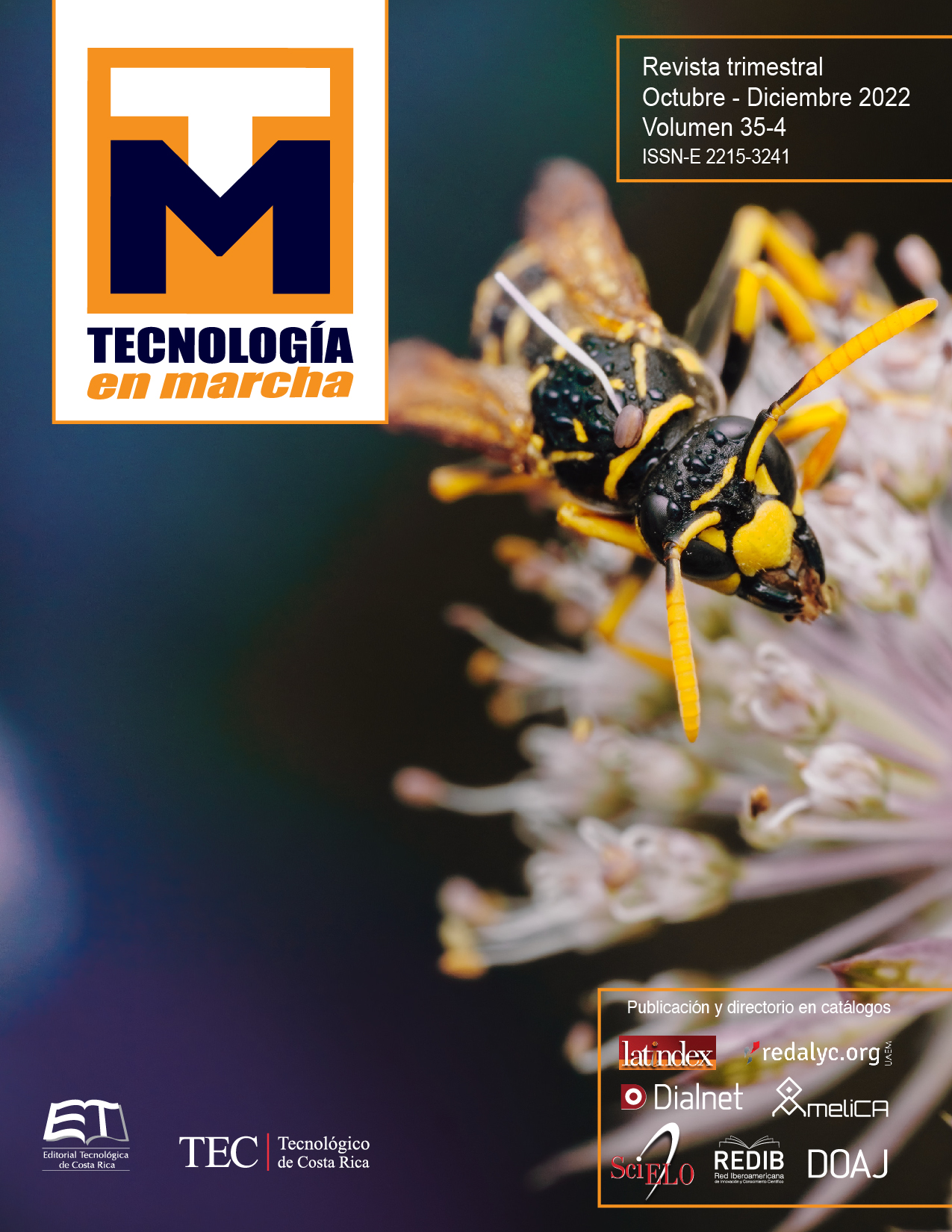Case Study: analysis of flood adaptation measures through the simulation of an event in the Matina Limón river, Costa Rica
Main Article Content
Abstract
The proximity of urban and extensive agricultural areas to the rivers of the Atlantic watershed in Costa Rica contrasts with its unstable morphology. Additionally, changes on the rain regime have increased the frequency of natural disasters affecting regularly the nearby populations and the economy of the country. Detailed studies demonstrating the impact of rivers in urban areas and high agricultural activity are necessary to establish adequate flood mitigation and control measures. The present study shows a case study of the impact of a 25-year flood event on the flood plain of the Matina River in Costa Rica, by means of a bi-dimensional hydraulic modelling with the aim to contribute to the adequate management of land use and the establishment of protection measures in the study vregion. A digital elevation model, of the topography of the study area, obtained with a LIDAR device, and the estimation of the instantaneous peak flow was obtained with the statistical Weibull distribution for a return period of 25 years, allowed to provide satisfactory information for the flood analysis of complex combinations for surface drainage management. Two scenarios for flood management were analyzed: 1) increasing the dike height, and 2) early opening of an additional mouth at the river outlet during the flood events. The study demonstrated that none of the options were technically feasible and that decision makers should explore other flood mitigation alternatives.
Article Details

This work is licensed under a Creative Commons Attribution-NonCommercial-NoDerivatives 4.0 International License.
Los autores conservan los derechos de autor y ceden a la revista el derecho de la primera publicación y pueda editarlo, reproducirlo, distribuirlo, exhibirlo y comunicarlo en el país y en el extranjero mediante medios impresos y electrónicos. Asimismo, asumen el compromiso sobre cualquier litigio o reclamación relacionada con derechos de propiedad intelectual, exonerando de responsabilidad a la Editorial Tecnológica de Costa Rica. Además, se establece que los autores pueden realizar otros acuerdos contractuales independientes y adicionales para la distribución no exclusiva de la versión del artículo publicado en esta revista (p. ej., incluirlo en un repositorio institucional o publicarlo en un libro) siempre que indiquen claramente que el trabajo se publicó por primera vez en esta revista.
References
INEC, “Indicadores Demográficos Regionales. 2013,” 2015.
S. Mora Ramírez, “Indicadores macroeconómicos 2015-2019,” 2019.
COSAR, “Plan regional de desarrollo agropecuario y rural central oriental 2015-2018,” 2015.
S. Vallejos, L. Esquivel, and M. Hidalgo, “Histórico de desastres en Costa Rica,” 2012.
L. Segura and R. Casasola, “Modelación hidráulica para el análisis y propuesta de obras de mitigación de inundaciones en finca valle la estrella,” 2011, pp. 1–171.
H. Morris Grainger, “Modelacion hidraulica e hidrologica del rio Guapiles para determinar la vulnerabilidad a inundaciones en un tramo comprendido entre los poblados Guapiles y la Rita.,” 2006.
J. Barrantes, G. Vargas, “Zonificación de amenazas por inundación en el Valle del río Sixaola,” 1996.
F. Lempérière, “Dams and Floods,” Engineering, 2017, vol. 3, pp. 144–149, doi: 10.1016/J.ENG.2017.01.018.
D. Bocchiola and R. Rosso, “Safety of Italian dams in the face of flood hazard,” Adv. Water Resour., 2014, vol. 71, pp. 23–31, doi: 10.1016/j.advwatres.2014.05.006.
G. Zhou et al., “Experimental investigation on the longitudinal evolution of landslide dam breaching and outburst floods,” Geomorphology, 2019, vol. 334, pp. 29–43, doi: 10.1016/j.geomorph.2019.02.035.
F. Wang, Z. Dai, C. A. Udechukwu Okeke, Y. Mitani, and H. Yang, “Experimental study to identify premonitory factors of landslide dam failures,” Eng. Geol., 2018, vol. 232, pp. 123–134, doi: 10.1016/j.enggeo.2017.11.020.
X. Jiang, Y. Wei, L. Wu, and Y. Lei, “Experimental investigation of failure modes and breaching characteristics of natural dams,” Geomatics, Nat. Hazards Risk, 2018, vol. 9, pp. 33–48,doi: 10.1080/19475705.2017.1407367.
T. Tu, K. J. Carr, A. Ercan, T. Trinh, M. L. Kavvas, and J. Nosacka, “Assessment of the effects of multiple extreme floods on flow and transport processes under competing flood protection and environmental management strategies,” Sci. Total Environ., 2017, vol. 607–608, pp. 613–622, doi: 10.1016/j.scitotenv.2017.06.271.
X. Zhang and Y. Song, “Optimization of wetland restoration siting and zoning in flood retention areas of river basins in China: A case study in Mengwa, Huaihe River Basin,” J. Hydrol., 2014, vol. 519, no. PA, pp. 80–93 ,doi: 10.1016/j.jhydrol.2014.06.043.
S. Arlikatti, P. Maghelal, N. Agnimitra, and V. Chatterjee, “Should I stay or should I go? Mitigation strategies for flash flooding in India,” Int. J. Disaster Risk Reduct., 2018, vol. 27, pp. 48–56, doi: 10.1016/j.ijdrr.2017.09.019.
M. P. Mabuku, A. Senzanje, M. Mudhara, G. Jewitt, and W. Mulwafu, “Rural households’ flood preparedness and social determinants in Mwandi district of Zambia and Eastern Zambezi Region of Namibia,” Int. J. Disaster Risk Reduct., 2018, vol. 28, pp. 284–297, doi: 10.1016/j.ijdrr.2018.03.014.
QGIS Development Team, “QGIS Geographic Information System. Open Source Geospatial Foundation
Project.,” 2019. .
E. Bladé et al., “Iber: herramienta de simulación numérica del flujo en ríos,” Rev. Int. Métodos Numéricos para Cálculo y Diseño en Ing., 2014, vol. 30, pp. 1–10, doi: 10.1016/j.rimni.2012.07.004.
IMN, “Tablas de mareas,” 2018. .
K. H. Liao, T. A. Le, and K. Van Nguyen, “Urban design principles for flood resilience: Learning from the ecological wisdom of living with floods in the Vietnamese Mekong Delta,” Landsc. Urban Plan., 2016, vol. 155, pp. 69–78, doi: 10.1016/j.landurbplan.2016.01.014.
K. Kuntiyawichai, B. Schultz, S. Uhlenbrook, F. X. Suryadi, and A. Van Griensven, “Comparison of flood management options for the Yang River Basin, Thailand,” Irrig. Drain., 2011, vol. 60, no. 4, pp. 526–543, doi:
1002/ird.596.

